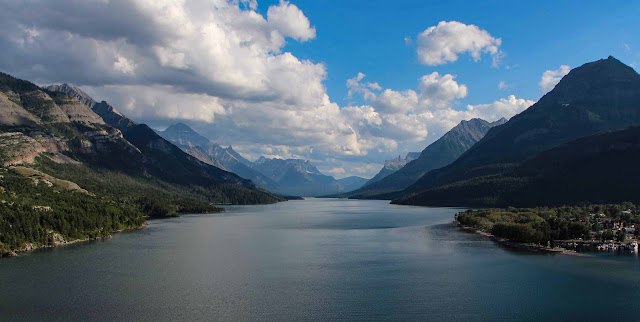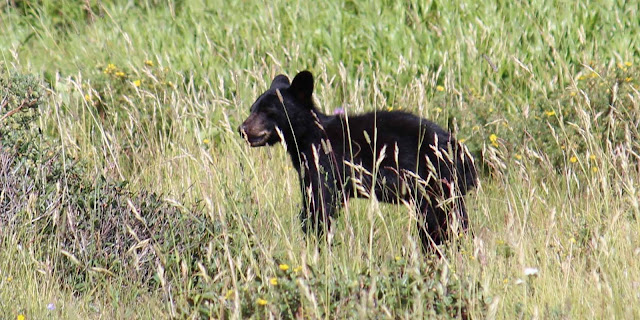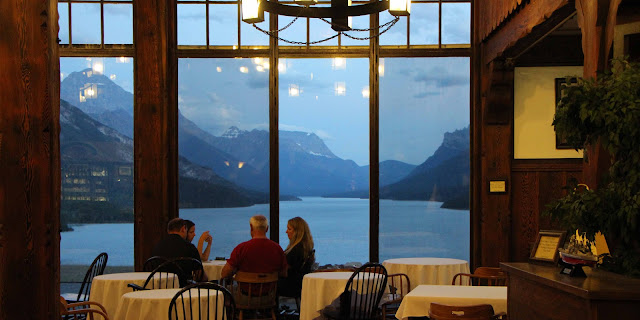 |
| The Park's namesake, Waterton Lake |
 |
| It did cool down at night |
The Park
Sitting on the other side of the Canadian border from Glacier National Park in Montana, Waterton was created in 1895 and named after Waterton Lake, which, in turn, was named after Victorian naturalist and conservationist Charles Waterton. It has 195 square miles of rugged mountains and wilderness.
 |
| We were getting pretty used to rugged wilderness, but never bored by it |
 |
| Map: WGIPP Association |
In 1979, Waterton became Canada's second biosphere reserve, dedicated to improving the relationship between humans and the natural environment.
Waterton-Glacier International Peace Park was inscribed a UNESCO World Heritage Site in 1995.
 |
| Waterton Lake |
Unlike the Canadian Rockies, which has significantly inclined sedimentary strata, Waterton's sediments are characterized by a single overlap that moved as a unit, more or less, horizontally over newer rocks, creating the rare circumstance of old rocks over young.
 |
| Interesting rocks |
Although there are no glaciers left in Waterton, aside from a few expanses of eternal snow, the landscape has been greatly shaped by the Wisconsin glaciation. The park has many glacial troughs, hanging valleys, ridges, cirques, kames (steep-sided mounds of sand and gravel deposited by a melting ice sheet) and eskers (long ridges of gravel and sediment, typically having a winding course, deposited by meltwater from a retreating glacier).
 |
| The designations celebrate and protect nature |
Waterton Lakes National Park spans four ecoregions: foothills parkland, montane, subalpine and alpine.
The Lake
The lake itself is composed of two bodies of water, connected by a shallow channel known locally as the Bosporus. The two parts are Middle Waterton Lake and Upper Waterton Lake, which straddles the U.S./Canada border.
 |
| View from above |
Two thirds of Upper Waterton is in Canada and the rest is in Glacier National Park in the U.S. Lower Waterton Lake is north of Middle Waterton Lake and is separated by a channel known as the Dardanelles.
 |
| The town of Waterton on the shore of the lake |
The Upper and Middle Waterton Lake system has a surface of 3.9 square miles, while Lower covers slightly more than a half mile. It's greatest depth is 490 feet.
 |
| Waterton Lake |
The Waterton River flows north from the Lower Waterton Lake.
 |
| The baby Black Bear has heart |
Wildlife
Animals that inhabit the Park Wolverines, Bighorn Sheep, Bald Eagles, White-tailed and Mule Deer, Mountain Goats, Elk, Moose, Foxes, Timber Wolves, Bison, Coyotes, Beavers, River Otters, Cougars, Lynx, Bobcats, Snowshoe Hares, Pikas, Hoary Marmots, Grizzly and Black Bears.
Did we see all those animals? Absolutely not! We saw some Deer ...
 |
| Cute Mule Deer |
... and a lone female Moose ...
 |
| Moose sightings had been pathetic throughout the trip |
But, the Bear drought finally ended. We saw nine Black Bears, including a mom and two cubs at very close range feeding on a hillside right across from the Prince of Wales parking lot.
And, this wasn't just a quick glance-and-go.
 |
| A tiny baby |
Nope. Mom was completely absorbed in feeding and did not seem inclined to move anywhere.
 |
| Those summer flowers are sweet |
And, the cubs were fascinated by the group of people gathered to take their picture.
 |
| What's happening? |
A couple of times, I thought some of the photographers got way too close. I am surprised that a Ranger didn't come to break it up ...
 |
Bear jam |
... or that the mom didn't come after us ...
 |
| Close encounter |
 |
| Swiss/Rustic – is that a thing? |
The Hotel
We opted to go big and stay at the
Prince of Wales Hotel, which, miraculously, had a vacancy.
This grand old hotel is not really that luxurious, but its locale and view are incredible.
The Hotel was designed by and built for the Great Northern Railway Company, opening in 1927 in an attempt to lure American tourists to Canada during Prohibition. The hotel is the only grand railway hotel in Canada to be constructed by an American railway company.
 |
| Prince of Wales Hotel |
The seven-story hotel was named after the Prince of Wales (later King Edward VIII), in a transparent attempt to entice him to stay there on his 1927 Canadian tour, but he didn't take the bait. Instead, he stayed at his own nearby ranch in Pekisko, Alberta.
 |
| The 1927 royal entourage (the Prince is in the middle) |
The hotel was designated as a National Historic Site of Canada in 1992.
 |
| The hotel has a commanding presence |
The building was designed in a Rustic architectural style, although it also adopts a number of elements from the Swiss chalet style. The majority of the lumber was provided by sawmill in Somers, Montana. The lobby for the Prince of Wales Hotel is perpendicular to the length of the building, and incorporates two-story windows facing Upper Lake Waterton.
 |
| Grandeur |
The hotel's timber-framed lobby features hand-carved posts and beams.
The Royal Stewart Dining Hall features large windows that look over Upper Waterton Lake. We had a lovely dinner (trout for me, lamb for Scott) in the dining room as we looked at the lake. Our breakfast the next morning was not as successful. how does a Canadian restaurant serve raw pancakes?
 |
| Nice view, hit and miss food |
Activities
Scott finally got to fish (unfortunately, he fished but didn't catch).
And, I finally got to hike. One of my big regrets on this trip is that I did not get to hike much – lots of reasons including weather, mosquitoes, Bears and driving about looking for Bears.
But, in Waterton, I took a wonderful hike. Six and a half miles, 1,509 feet in elevation gain.
 |
| A very well-maintained trail |
The trail wound through both forest and high shrubs as it, first, skirted Waterton Lake and then turned into a canyon.
The first attraction was Bertha Falls, a lovely cascade down an angled rock.
 |
| Bertha Falls |
 |
| Hard to photograph |
After some switchbacks and winding around, I came to Bertha Lake.
 |
| The lake is prettier than its name |
Sublime. Blue green water surrounded by granite cliffs and the last few trees at treeline.
 |
| This is why we hike |
On the way back down, just after I had traversed an area of the trail the cuts through dense, tall plants, some hikers asked if I saw "the Bear." The Bear? I did not. But, I guess I passed it. Yikes! I never heard if it was a Grizzly or a Black Bear. Whatever.
It was a marvelous hike in a beautiful place.
Trip date: June 3-July 20, 2013

No comments:
Post a Comment